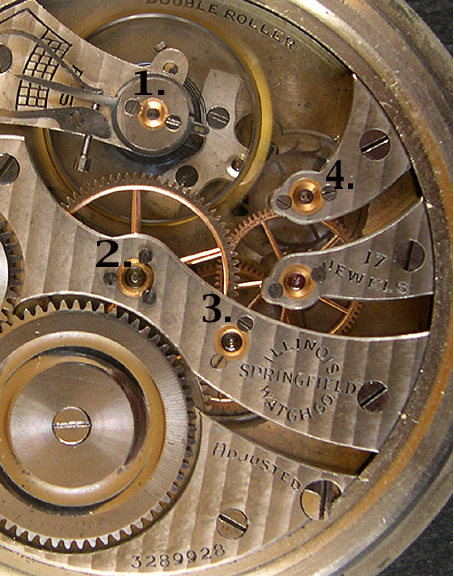
| WWT Shows | CLICK TO: Join and Support Internet Horology Club 185™ | IHC185™ Forums |

|
• Check Out Our... • • TWO Book Offer! • |
Welcome Aboard IHC185™  Internet Horology Club 185
Internet Horology Club 185  IHC185™ Discussion Site Main Page
IHC185™ Discussion Site Main Page  Horological Discussions, Questions and Answers
Horological Discussions, Questions and Answers  Pocket Watch Discussions
Pocket Watch Discussions  Jewel color
Jewel color
 Internet Horology Club 185
Internet Horology Club 185  IHC185™ Discussion Site Main Page
IHC185™ Discussion Site Main Page  Horological Discussions, Questions and Answers
Horological Discussions, Questions and Answers  Pocket Watch Discussions
Pocket Watch Discussions  Jewel color
Jewel colorGo  | New Topic  | Find-Or-Search  | Notify  | Tools  | Reply to Post  |  |
I was looking over the watch in the pictures below preparing to offer it for sale on the auction block when I noticed it had 4 jewels (I numbered them in the first picture) that appeared clear to me; the 5th was pink. I was a bit stressed over this. Did a previous owner rob the original jewels and replace them with glass? Are they synthetic rubies? do some rubies have little or no color? Do people replace cracked jewels with pink glass? What do we know about jewel color? Do we just have to go on faith we have real jewels in our watches? This is from a size 16, grade 303, Illinois.  | |||
|
This picture was taken with my camera through a stereoscope whose idea I got from this web site. I like it! A body can get up close and personal with this method. Anyway,it shows pretty well the color difference between the various jewels in this watch.  | ||||
|
| IHC Life Member |
Mike, large scale production of sapphire and Ruby jeweling in the US and Europe was made possible in the late 19th century due to the development of synthetics that made these watch jewels very easy to form and finish. Unfortunately many of the synthetic Ruby and Sapphires produced were clear to milky opaque appearing "jewels" which limited their use as gems but left them eminently usable for watch jeweling. So you see the color variants. Some of these were actually dyed red which we see somtimes "washing off" when we clean the watches. The only "colored Glass" jewels used were by the "swiss fakers" who glued flat glass beads around the metal pinion bearings to make their junk "look jeweled". A short history of synthetic rubies is as follows; "By 1891 Auguste Verneuil was producing rubies by flame fusion, although he did not publish a description of his technique until 1902. His assistant exhibited the synthetic rubies in 1900 at the Paris World's Fair, where they were quite popular. His process took only two hours to grow crystals weighing 12-15 carats (2.5-3 g); the stones were roughly spherical, up to 0.25 in (6 mm) in diameter. By the time Verneuil died at the age of 57 in 1913, the process he had invented was being used to manufacture 10 million carats (2,000 kg, or 4,400 lb) of rubies annually. In 1918, J. Czochralski developed a different method for synthesizing rubies. Known as crystal pulling, this technique is fast, inexpensive, and effective in producing flawless stones. In fact, when cut as gems the stones are so clear that they look like glass imitations. Consequently, this technique is now used primarily for manufacturing industrial-use rubies. I must add the crystal pulling method was later revised into what is used today to make the vast quantities of silicon and sapphire crystals so essential to semiconductor performance. | |||
|
| IHC Life Member |
Interesting question Mike, I have ofter wondered the same thing.... It will be interesting answers I'm sure....from our more expert members.... Opps, Dave beat me to it....I told you so... Regards, Jerry | |||
|
| IHC Life Member |
In the 1923 Illinois material catalogue, replacement jewels were available in "red ruby", "pale ruby", and, sometimes, "sapphire." You may have a replacement jewel that the watchmaker had in his stock. Bob | |||
|
In 'old times', before ruby stomes could be made syntheticly, the jewels used in watches were ' bad quality gem-stones ( pale ore opaque). In 19'th century watches you often find near colourless stones in the dial plale and the 'better quality' (more pink) in the visilbe settings. When synthetic stones were available, the colour changed more and more to 'full red'. So the one 'not matching' stone should be a replace (repair) stone. In my eyes one visible only by colour replacement jewel shows only that someone cared about his watch and had it proper repaired instead of buying a new watch.(Others think a 'non-matchching' stone is a devaluation). Regards, Gerald | ||||
|
Most excellent information fellows. I do appreciate it. I especially like Gerald's view that the single pink jewel meant the owner took good care of his watch with a proper repair and was not fussy about the jewel color. The watch is uncommonly clean. Best, Mike | ||||
|
| IHC Life Member |
Nice discussion topic. In this case the 1918 vintage of this watch puts it smack dab in the synthetics. | |||
|
| Powered by Social Strata |
| Your request is being processed... |
|
©2002-2025 Internet Horology Club 185™ - Lindell V. Riddle President - All Rights Reserved Worldwide

